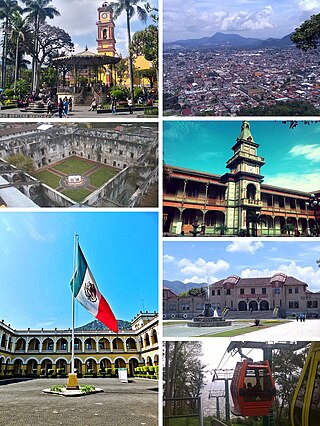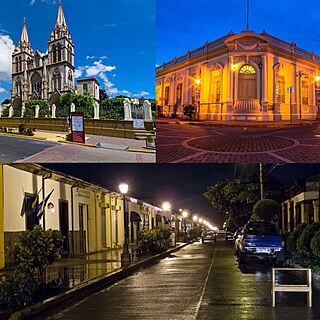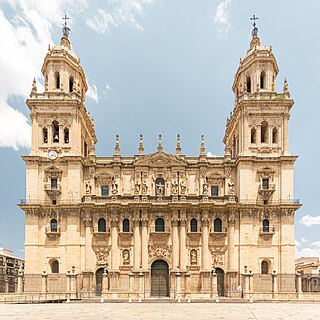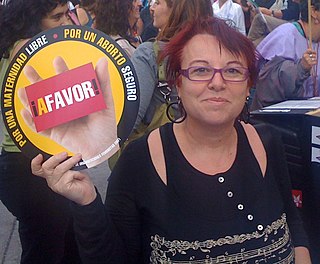
Guadalupe Victoria, born José Miguel Ramón Adaucto Fernández y Félix, was a Mexican general and politician who fought for independence against the Spanish Empire in the Mexican War of Independence and after the adoption of the Constitution of 1824, was elected as the first president of the United Mexican States. He was a deputy in the Mexican Chamber of Deputies for Durango and a member of the Supreme Executive Power following the downfall of the First Mexican Empire, which was followed by the 1824 Constitution and his presidency. He later served as Governor of Puebla.

Orizaba is a city and municipality in the Mexican state of Veracruz. It is located 20 km west of its sister city Córdoba, and is adjacent to Río Blanco and Ixtaczoquitlán, on Federal Highways 180 and 190. The city had a 2020 census population of 120,500 and is almost coextensive with its small municipality, with only a few small areas outside the city. The municipality, with an area of 27.97 km2, had a population of 123,182. While the metropolitan area of Orizaba has a population of 462,261 as 2020.

Santa Tecla is a city and a municipality in the La Libertad department of El Salvador. It is the capital of the department of La Libertad.
Pedro Thomas Ruiz de Velasco de la Madrid was a Mexican businessman and the family holder of several historical documents from Mexico including the original Acta de Independencia del Imperio Mexicano de 1821.
Juan Francisco Azcárate y Lezama was a lawyer, a Mexico City councilman, and a leader of the movement for Mexican independence from Spain.

The historic center of Mexico City, also known as the Centro or Centro Histórico, is the central neighborhood in Mexico City, Mexico, focused on the Zócalo and extending in all directions for a number of blocks, with its farthest extent being west to the Alameda Central. The Zocalo is the largest plaza in Latin America. It can hold up to nearly 100,000 people.

The Cathedral of the Assumption is a Roman Catholic cathedral located in the city of Jaén, Spain.

Tila is a town and municipality in the Mexican state of Chiapas in southern Mexico.

Francisco Antonio de Guerrero y Torres was a Mexican Baroque architect who was prominent in Mexico City, the capital of New Spain. He built several palaces and buildings at the basilica devoted to Our Lady of Guadalupe.
San Hipólito Hospital is a general medical facility in Mexico City that began as the first psychiatric facility in the Americas. It was founded by Brother Bernardino Álvarez in 1569. It was supported by the first religious order in Mexico called San Hipolito Order of Charity. The money used to maintain the hospital came from alms that Christians collected on the streets. The people who worked on San Hipólito Hospital were prisoners, captured pirates and slaves, which included the indigenous. The hospital's building has changed its purpose several times. It started as a psychiatric hospital that then changed into a military base, which three years later was used again as a hospital. In 1905, the building was partially destroyed. When it was rebuilt, it became a shelter for poor people. At the end of 1970, the facilities were once again a hospital but this time as a general medical center.
Blanca López de Mariscal or Blanca Guadalupe López Morales is a Professor emeritus and researcher in literature at Tecnológico de Monterrey, Campus Monterrey, México.

Elena Arizmendi Mejía was a Mexican feminist who established the Neutral White Cross to care for casualties of the Mexican Revolution that the Red Cross would not aid. Participating in the first wave of Mexican feminism, she established two international women's rights organizations: the "Mujeres de la Raza" and the International League of Iberian and Latin American Women.

The Count of Guadalupe del Peñasco is a title of Spanish nobility granted by KingCharles III of Spain to Don Francisco Javier de Mora y Luna, Colonel of Dragons of the provincial militias on 26 January 1768.

Yayo Herrero López is a Spanish anthropologist, engineer, professor and ecofeminist activist. She is one of the most influential researchers in ecofeminism and ecosocialism at European level.

Montserrat Boix Piqué is a Spanish journalist, considered among the most influential women in her country. In early 2000, she created and developed the concepts of social cyberfeminism, and a year later those of feminist hacktivism. Another of her main areas of work is gender violence and communication. She has also stood out as a defender of the right to communication and citizenship rights for women. Since 1986, she has been a journalist for the Information Services of Televisión Española (TVE), in the international section.

The Monument to Isabella the Catholic is an instance of public art located in Madrid, Spain. A work by Manuel Oms, the monument is a sculptural bronze ensemble consisting of an equestrian statue of Isabella of Castile, accompanied by Pedro González de Mendoza and Gonzalo Fernández de Córdoba.

Corazón guerrero is a Mexican telenovela that aired on Las Estrellas from 28 March 2022 to 9 September 2022. The series is produced by Salvador Mejía for TelevisaUnivision. It is an adaptation of the Argentine telenovela Valientes, and stars Alejandra Espinoza and Gonzalo García Vivanco.

The Ferrer-Dalmau Art and History Foundation (FFD), better known as the Ferrer-Dalmau Foundation, is a Spanish non-profit foundation founded on June 30, 2021 by the Spanish painter and academic Augusto Ferrer-Dalmau, known as the Painter of Battles. Its purpose is the dissemination, training and enhancement of the historical, artistic and cultural resources of Spain by carrying out activities such as workshops, exhibitions, forums, etc. To fulfill this task, different arts are used, such as painting, sculpture, architecture, literature, comics, music or cinema, among others.















